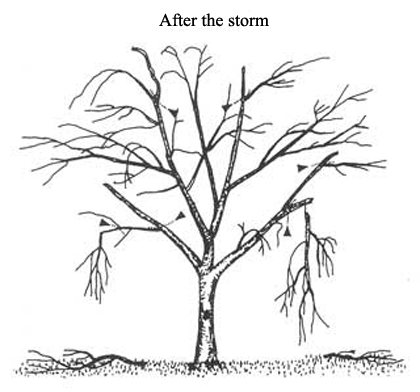Tree Pruning Tips
- 2023-03-05
- By mkirk
- Posted in Horticulture, The Garden Buzz
By Mae Lenoir Rauen, Emeritus Master Gardener
For most Coloradans, the first snowfall of the season is a charming event. The browns and grays of autumn are covered with white, and sounds have become muffled by the fresh snow. Occasionally you may even notice the earthy aroma of petrichor, the scent created when rain or wet snow falls on dry soil. Unfortunately, a heavy storm, especially the all-too-frequent “early” storm, may also bring the harsh sound of breaking branches as snow load stresses trees with leaves still attached or trees in need of pruning. Much tree damage can be prevented, or at least lessened, by regular and correct pruning.


Pruning of many deciduous trees such as Maple and most evergreens must be done while the tree is dormant. Wait until after leaf fall is complete and the tree has had time to “harden off” for winter. Better yet, plan to prune trees during late winter and early spring before bud break has begun. It is more efficient to prune trees during dormancy as bare branches are more visible and accessible and lighter to handle. Pruning also opens up dense canopies allowing more sunlight to reach grasses and other plants in the landscape. Trees are wounded in the pruning process and need adequate time to “heal” or seal off the wounded area to prevent spread of damage or disease. During the dormant season trees are already at rest and will experience less stress. Wound dressings are not recommended.
Smaller trees and shrubs can be pruned by homeowners. Take some time to study the plant and use brightly colored paint or ties to mark the branches that need to be removed. Look for broken or diseased limbs and areas where one branch rubs against another. Proper pruning cuts will prevent tearing of bark tissue. Use the 3-step pruning method as illustrated below.

It may be necessary to hire a tree care professional for larger trees. Tree companies will typically give free estimates for pruning work you need to have done. Look for companies that are insured and licensed. Ideally, there will be an arborist certified with the International Society of Arboriculture (ISA) on staff. Get at least three estimates and talk with the staff person to ascertain their knowledge and level of expertise. The lowest estimate may not necessarily be the best choice. It’s a good thing if they tell you they are a “tree hugger.” It means they truly love trees and are committed to managing the landscape to keep trees healthy, safe, and beautiful.
For more information on pruning and other yard and garden topics, visit www.cmg.extension.colostate.edu or www.extension.colostate.edu.
Horticulture Resources
- Garden Buzz Archives
- CSU Extension Resources
- Colorado Master Gardener Program
- Foothills to Plains Native Plant Master Program
- Native Bee Watch Community Science Program
- The Co-Hort Blog
- PlantTalk Colorado
- Soil Testing
- Plant Select
- Emerald Ash Borer
- Japanese Beetle
- Colorado State Forest Service
- Ask an Expert

